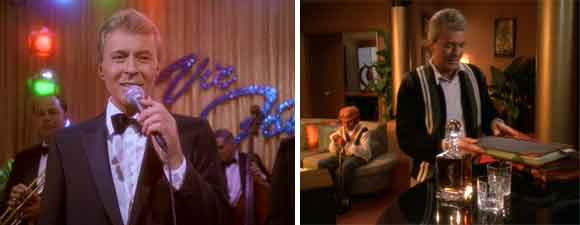Retro Review: Chimera
8 min readThe discovery of another isolated changeling leads Odo to reconsider his devotion to Deep Space Nine and his bond with Kira.
Plot Summary: When a spaceborne creature enters his runabout and transforms, Odo is thrilled to meet a shapeshifter who like himself was sent as an infant to explore the universe. But Laas – who came to consciousness among the Varalans and knows nothing of the Dominion – does not trust humanoids and does not believe that changelings and humans can share true bonds, particularly after Odo introduces him to the power of the link. Odo can hide nothing from Laas, not even the fact that, were it not for Kira, Odo would be with the other shapeshifters. Yet he argues when Laas suggests that Odo has limited himself by choosing to live as a humanoid, and is resistant when Laas wishes to shapeshift and link in public. Laas believes that it is their destiny to find the rest of the abandoned infant shapeshifters to form a new Great Link, and Kira fears that Odo secretly wishes to do so, though Odo insists that his love for Kira is stronger than his desire to live among his own people. When a Klingon mistakes Laas for a Founder and tries to stab him, Laas creates a sword from his own arm and kills the Klingon. Martok demands an extradition hearing, and because Sisko and Worf concur, Odo realizes that they have a double standard for humanoid and changeling behavior. Quark warns Odo that humanoids are genetically inclined to fear what they can’t comprehend and suggests that he not shapeshift in front of Kira. Although Kira tells Odo that she knows him to be a good, honest man, Odo points out that this is just a form he has assumed, not his true self. Not wanting Odo to feel trapped, Kira helps Laas to escape, then tells Odo where to find him so that he can leave the station for good. Though Odo follows Laas, it is to say goodbye, since he has decided that the love he shares with Kira is more than enough reason to remain with her. Back on the station, Odo finds Kira praying to the Prophets for his happiness. She says that she wants to know his true self, and he transforms into a radiant aura that surrounds and envelops her.
Analysis: A day may come when the last scene of “Chimera” does not make me burst into tears, but it is not this day. If I could only rewatch three episodes of Deep Space Nine ever again, they would all be Kira/Odo stories – “Duet,” “Necessary Evil,” and this one – so it’s obvious that I’m more invested in these characters and their relationship than any other, but that’s not the main reason I think “Chimera” is the best love story in the history of television, the episode I want to force a viewing for all the blokes writing schlocky genre who think that romance should only be used as an excuse for sex or action-inspiring angst. Ironically, since it’s an episode focused on aliens, “Chimera” may be the most clear story about what it means to be human since Kirk blew up the Enterprise to have a chance at saving Spock. As even Laas agrees, it isn’t the decision to wear a humanoid form or to live by humanoid standards that keeps Odo tethered to the solids: it’s his decision to love one, and to keep loving her in spite of all the challenges and sacrifices they both face. To touch upon a more recent science fiction story, Odo demonstrates the concept that Anne Hathaway’s Dr. Brand clumsily tries to put into words in Interstellar: “Love is the one thing we’re capable of perceiving that transcends dimensions of time and space.” This is true for Odo even though he’s capable of breaking through barriers that humanoids can’t approach, and even though, in the end, he and Kira will both understand that their physical differences may make a life together impossible (I don’t take the series finale as the last word on their relationship, but it’s apparent throughout the final arc that they need to grow apart for a time before they can grow together again). Rewatching the story is heartbreaking because the seeds of their separation are sown in their reunion: they love each other enough to know that they may have to let each other go. Nana Visitor and Rene Auberjonois are astonishing in their ability to convey so much complexity in a few glances and quiet words.
It’s probably because and not in spite of the piecemeal way in which Kira and Odo’s relationship develops that it ends up being so powerful. The writers mentioned several times that they didn’t intend to do anything with the implication, first made apparent via Auberjonois’ performance, that Odo was in love with Kira, then they said they intended to keep it unrequited, and only decided to allow the two to fall in love once they had also decided to separate them at the end of the series when Odo would return to the Founders. Yet there are hints as early as “Past Prologue” that Odo has very strong feelings for Kira, so that by the time he confesses his feelings aloud in “Heart of Stone,” they don’t sound contrived or constructed the way the Worf/Dax and Paris/Torres love affairs feel to me in their early stages. Even episodes where I don’t like the way Odo and Kira’s relationship is characterized, like “Crossfire” and “Children of Time,” improve in retrospect, since we can see that everything Laas says about Odo is true – that loving Kira forces Odo to constrain himself according to humanoid behaviors and customs, that Odo’s entire self-definition revolves around Kira and what he believes she would want for him (and he grows, for the Odo who refuses to let Kira die in “Children of Time” evolves to be the Odo willing to accept her choice to risk her life in “The Reckoning”). Meanwhile – since they can’t link, so Odo can’t know it until she puts it into words – Kira is struggling with the idea that if she truly loves Odo, she can only show it by letting him be his true self, which may mean letting him leave her. All the stops and starts in their relationship that seem haphazard and poorly planned on a first viewing of Deep Space Nine come together when considered after the finale, when they appear to echo real-life stumbles, not the meet-cute, act-adorable, time-constrained architecture of nearly every other television romance. “Chimera” is the consummation of all the fear and distrust worked through from “Necessary Evil” to “Things Past” to “Favor the Bold” to “His Way,” in which Kira and Odo painfully discover one another’s secrets and begin to forgive them.
I need to talk at least a bit about Laas, because the shift in the balance between Kira and Odo takes place because of his presence, even though Laas is rather unlikeable in his determination to bring Odo around to Laas’s own point of view, thus forcing Odo to be someone he’s not just as Laas accuses Kira of doing. J.G. Hertzler (acting under a different name, but it’s the same guy who plays Martok) gives a wonderful performance as a shapeshifter ostensibly older and wiser yet in some ways an innocent – his discovery of the glory of the link is like Geena Davis in Thelma and Louise, after decades of unsatisfying sex, suddenly discovering what all the fuss is about because she met someone willing to show her. The chemistry between Odo and Laas is nuanced and at times disturbing; virtual strangers, they link and thus share far more than Odo is comfortable putting in words, yet that intimacy doesn’t really help them to understand one another, while the awkward dialogue Odo must exchange with Kira in place of linking demonstrates a greater affinity. Seeing Odo with Laas makes it easier in retrospect to accept the reasons Odo kept linking with the female Founder even though he knew it would have catastrophic consequences for the people who mattered to him. The physical compulsion is overwhelming. Even at the end, when Odo has acknowledged that he doesn’t want to form a partnership with Laas, he reaches out as if to link with him, though he’s rebuffed. It’s painfully clear that being with Kira will never compensate for the absence of the Great Link, while at the same time we see the sacrifices they will make to remain together. I don’t think Kira thinks twice about breaking the law to free Laas – it’s recompense for tricking Odo into letting her go the very first time they met, when she was a killer and Dukat wanted her found – his alien biology has never been an issue for her as much as that complicated past with the Cardassians and her own ties to Bajor and its people, which he can never fully share any more than she can share in the Great Link.
The lovemaking scene at the end of “Chimera” is one of the most erotic I’ve ever seen, yet I’ve read that it makes some viewers uncomfortable. It’s inherently a challenge to one-man-one-woman, male-dominant sex that many conservatives insist is and should be the norm, as it was on television when the episode originally aired. It’s clear that we’re witnessing intense female pleasure – indeed, the melting, enveloping body Odo creates for himself could serve as a metaphor for female pleasure – and there’s not a male body to be seen, a reminder that even though Odo may look masculine, that’s how he constructs himself, not necessarily how he sees himself. It’s also clear that the merging of selves via the link has a pleasurable component that doesn’t limit itself to heterosexual pairings. It may not be arousal and fulfillment as humanoids experience those feelings, but when Odo has “solid” sex with the female changeling while she’s on the station, she compares that experience to linking, and Odo’s eyes go wide with pleasure when he links with Laas in exactly the same way as they did with her. We’ve had a couple of hints that Odo and Kira make love in ways not typical for humanoids – despite Quark’s admonitions about not appearing too alien, when Odo gives Kira back rubs, his hands become amorphous on her skin – and although Kira has sometimes seemed conservative about sex, choosing men from her own planet and making faces when Jadzia dated a man with a transparent skull, she’s also been shown to be responsive to sensuality and eager to take the initiative. Why would she want Odo to behave strictly as a humanoid, as Quark and Laas both insist she must, when he can instantly change shape, size, texture, temperature, position, with every point of contact serving as an erogenous zone? Apart from their inability to have children together, which Kira has never said she wants, she’s getting more than a humanoid lover could give her. Yet as Laas points out, in the best of all cases, Odo will watch her age and die. Does that mean it isn’t “forever” love? Does passion of the spirit exist apart from the bodies we’re stuck with? “Chimera” suggests that it can – that Infinite Diversity in Infinite Combinations exists in this most intimate of ways.







Don’t read the last paragraph unless you want the visual of Michelle becoming overwhelmed with passion during viewings of the last scene and engaging in things you’d really rather not think about.
Of course, it helps that there’s no nasty, brutish, dominant male body to be seen during it. Michelle prefers those to appear only in her hypothetical Bashir/O’Brien/Garak three-way episodes. It’s a good thing a man didn’t write “Chimera” because everyone knows that a man’s perceptions of romance are limited to sex and schlocky, action-inspiring angst.
Also, Kirk did not blow up the Enterprise to have a chance at saving Spock. He blew it up as an act of duty (to keep her from falling into enemy hands) and as a last-ditch act of revenge. You know how men are.
I love this episode, but it only drew my attention on a casual recent rewatch of season 7. I must not have noticed it when I was a kid, but it’s truly one of the best of the season, and of all DS9.
Was that sarcasm? No.
^ Was THAT sarcasm? NO.
^ First hand examples of Poe’s Law (http://rationalwiki.org/wiki/Poe%27s_Law) + Bulverism (http://en.wikipedia.org/wiki/Bulverism)